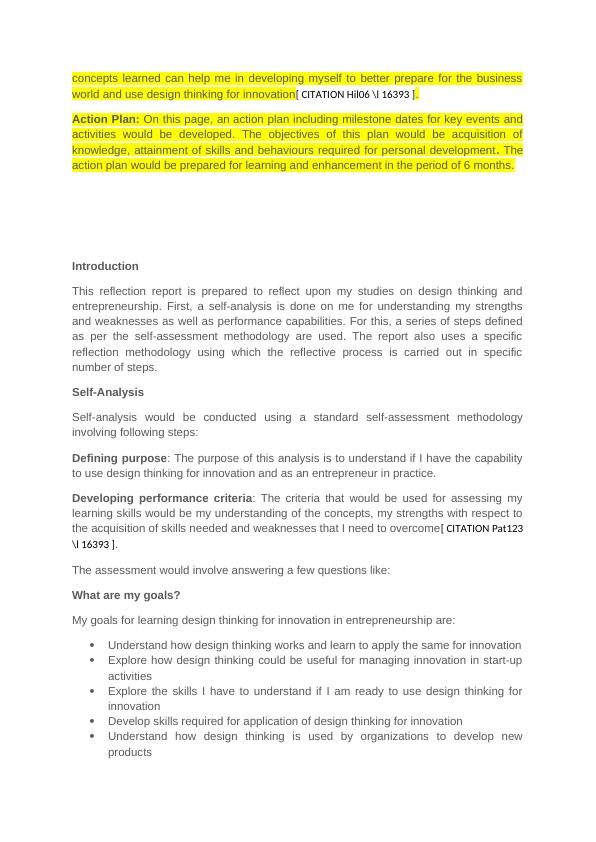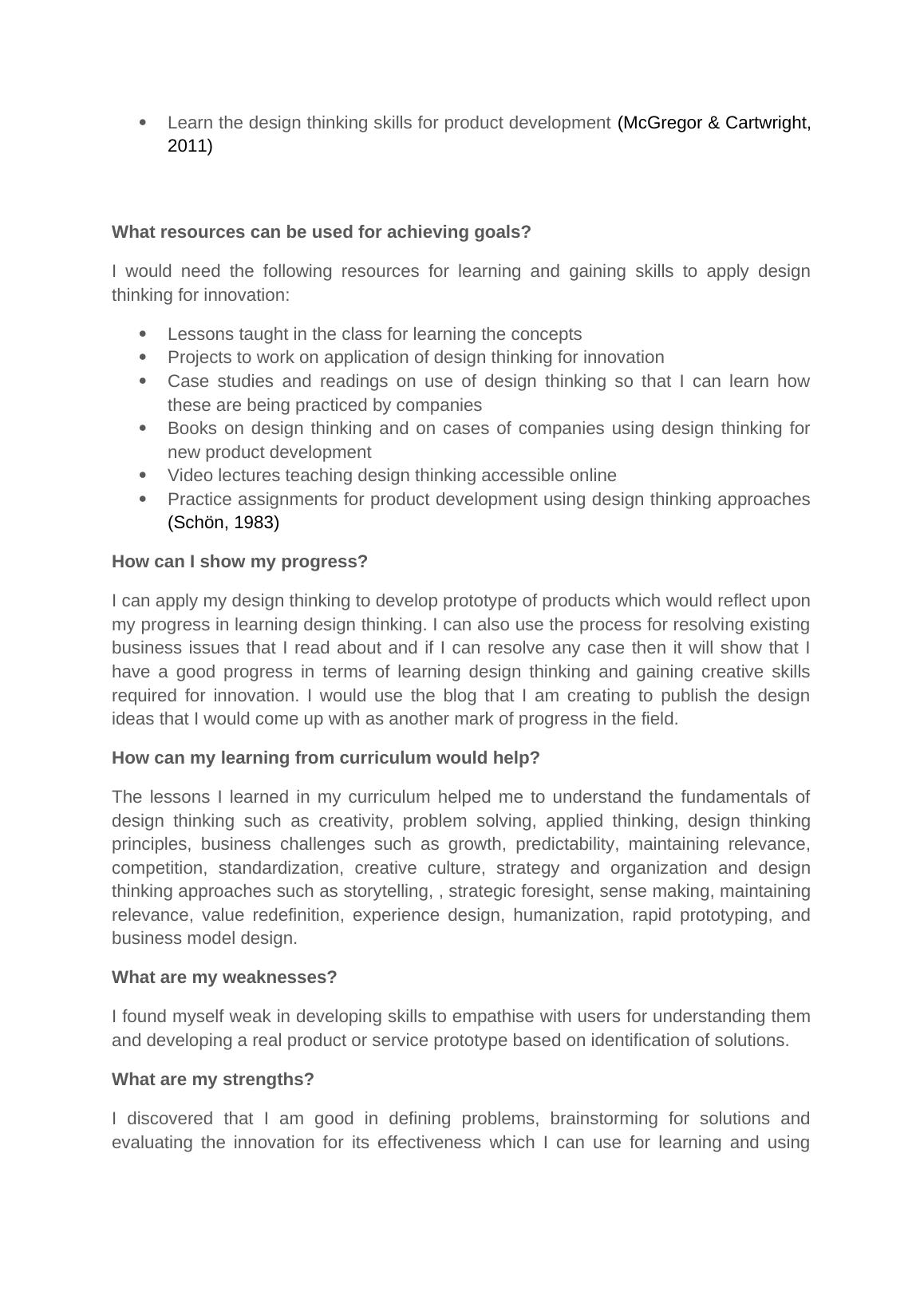Reflective Report on Design Thinking and Entrepreneurship
Added on 2020-04-07
9 Pages3818 Words1468 Views
Reflective report on Design ThinkingBlogFor presenting the reflective writing, a blog was created explaining the purpose ofreflective writing. This blog has four pages including the home page giving the brief ofdifferent sections divided into different pages that include learning, self-analysis,reflection, evaluation, personal development and action plan for improvement. The homepage content is presented below:Learning: This section would include the brief of what I have learnt in the class ondesign thinking and entrepreneurship. It would not include the module details but thebrief on lessons learned from my curriculum. The topics explored here try to explain theconnection between entrepreneurship and design thinking. It would also include themodels that could be used by start-up organizations for bringing innovation in theorganization. This includes exploration of innovation cycle, business models,frameworks, tools, etc. And topics like notion of creativity, role of creativity inentrepreneurship and innovation, role of designing in business, use of creativity inorganizations, approaches to study creativity, organisational influences on learningcreativity, and strategies that can be used for enhancing innovation through the use ofdesign thinking.Self Analysis: This section includes my own analysis of the strengths and weaknessesconsidering my ability to become an entrepreneur and use design thinking for personaldevelopment and innovation. For self-analysis, some questions would be answeredwhich would help me understand my goals, how I learn, and how my learning processcould help in personal development. Another tool that is used for self analysis is SWOTin which I have explored the strengths, weaknesses, opportunities and threats I havewith respect to use of design thinking for innovation in start-up organizations[ CITATIONBul13 \l 16393 ].Reflection: In this section, first the key outcomes of learning from the course on designthinking and entrepreneurship that include development of the skills required fordeveloping a new business concept, learn skills and techniques required for criticalthinking, and assessment of self for understanding my potential to use design thinkingfor innovating in an entrepreneurial setting[ CITATION CVC09 \l 16393 ]. Evaluation: This section would assess the self-analysis and reflective analysis to findout if the methodologies and techniques used in these two methods of learning andpersonal development have been effective for my personal development. The underlyingmodels and theories that helped develop a plan for the analysis would be explored forjustificationPersonal Development: This section would explore how learning in the course hashelped me in personal development. This would be based on the insights obtained in theself-analysis and reflection. The insights would help me understand how the skills and

concepts learned can help me in developing myself to better prepare for the businessworld and use design thinking for innovation[ CITATION Hil06 \l 16393 ].Action Plan: On this page, anaction plan including milestone dates for key events andactivities would be developed. The objectives of this plan would be acquisition ofknowledge, attainment of skills and behaviours required for personal development. Theaction plan would be prepared for learning and enhancement in the period of 6 months.IntroductionThis reflection report is prepared to reflect upon my studies on design thinking andentrepreneurship. First, a self-analysis is done on me for understanding my strengthsand weaknesses as well as performance capabilities. For this, a series of steps definedas per the self-assessment methodology are used. The report also uses a specificreflection methodology using which the reflective process is carried out in specificnumber of steps. Self-AnalysisSelf-analysis would be conducted using a standard self-assessment methodologyinvolving following steps:Defining purpose: The purpose of this analysis is to understand if I have the capabilityto use design thinking for innovation and as an entrepreneur in practice.Developing performance criteria: The criteria that would be used for assessing mylearning skills would be my understanding of the concepts, my strengths with respect tothe acquisition of skills needed and weaknesses that I need to overcome[ CITATION Pat123\l 16393 ].The assessment would involve answering a few questions like:What are my goals?My goals for learning design thinking for innovation in entrepreneurship are:Understand how design thinking works and learn to apply the same for innovationExplore how design thinking could be useful for managing innovation in start-upactivitiesExplore the skills I have to understand if I am ready to use design thinking forinnovationDevelop skills required for application of design thinking for innovationUnderstand how design thinking is used by organizations to develop newproducts

Learn the design thinking skills for product development[ CITATION McG11 \l 16393 ]What resources can be used for achieving goals?I would need the following resources for learning and gaining skills to apply designthinking for innovation:Lessons taught in the class for learning the concepts Projects to work on application of design thinking for innovationCase studies and readings on use of design thinking so that I can learn howthese are being practiced by companiesBooks on design thinking and on cases of companies using design thinking fornew product developmentVideo lectures teaching design thinking accessible onlinePractice assignments for product development using design thinking approaches[CITATION Sch83 \l 16393 ]How can I show my progress?I can apply my design thinking to develop prototype of products which would reflect uponmy progress in learning design thinking. I can also use the process for resolving existingbusiness issues that I read about and if I can resolve any case then it will show that Ihave a good progress in terms of learning design thinking and gaining creative skillsrequired for innovation. I would use the blog that I am creating to publish the designideas that I would come up with as another mark of progress in the field.How can my learning from curriculum would help?The lessons I learned in my curriculum helped me to understand the fundamentals ofdesign thinking such as creativity, problem solving, applied thinking, design thinkingprinciples, business challenges such as growth, predictability, maintaining relevance,competition, standardization, creative culture, strategy and organization and designthinking approaches such as storytelling, , strategic foresight, sense making, maintainingrelevance, value redefinition, experience design, humanization, rapid prototyping, andbusiness model design.What are my weaknesses?I found myself weak in developing skills to empathise with users for understanding themand developing a real product or service prototype based on identification of solutions. What are my strengths?I discovered that I am good in defining problems, brainstorming for solutions andevaluating the innovation for its effectiveness which I can use for learning and usingdesign thinking. Besides these, I have certain skills that can be productive for developingme for entrepreneurship such as:

End of preview
Want to access all the pages? Upload your documents or become a member.
Related Documents
Design Thinking and Entrepreneurship | Reportlg...
|12
|3392
|53
Reflective Report on Design Thinking Courselg...
|16
|4275
|199
Reflective Reportlg...
|11
|3579
|25
Individual Blog and Learning Reflectionslg...
|15
|3659
|180
Design Thinking and Innovationlg...
|11
|2991
|244
Report | Self-analysis of Entrepreneurshiplg...
|14
|3581
|103
